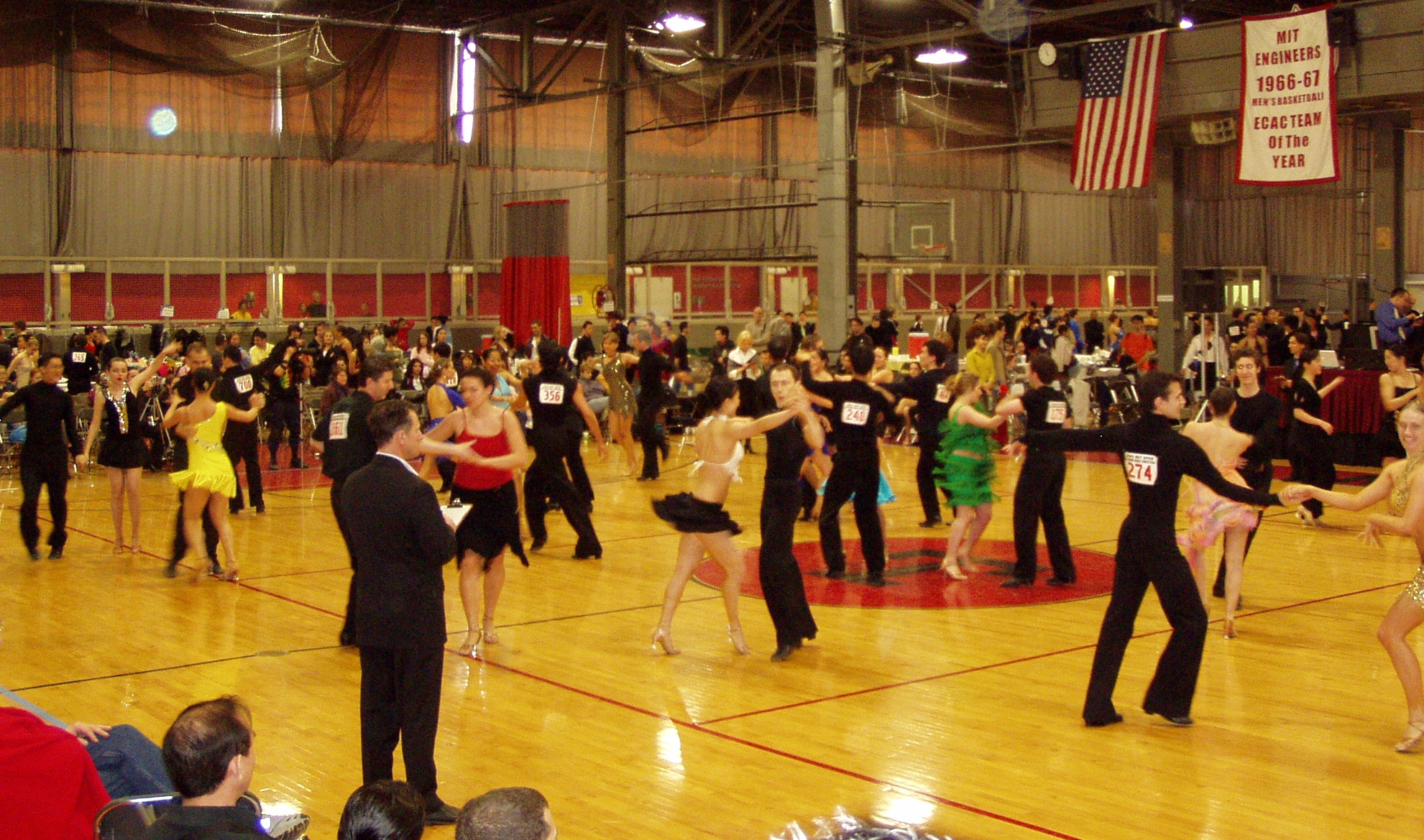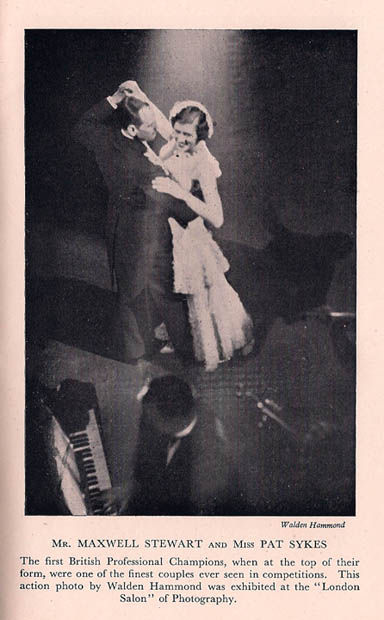Ballroom Dance Competition
From Londonhua WIKI
Ballroom Dance Competition
 | |
| Intermediate level Latin dancing at the 2006 MIT Ballroom Dance Competition, judge standing in foreground | |
|---|---|
| Credit: | Nathaniel C. Sheetz[1] |
Overview
Ballroom Dance Competitions, sometimes referred to as DanceSport, are organized and regulated competitions in which ballroom dancers perform for judges. Depending on the competition, finalists may win ribbons, cash, dance scholarships, or other prizes.
Format
Depending on the focus, a Ballroom competition might feature sections for any and all of the dances, from the Smooth/Standard styles to the Rhythm/Latin styles. These styles are broken down as follows[2].
- Smooth: Waltz, Foxtrot, Tango, Viennese Waltz
- Standard: Waltz, Foxtrot, Tango, Viennese Waltz, QuickStep
- Rhythm: Cha-Cha, Rumba, Swing, Mambo, Bolero
- Latin: Cha-Cha, Rumba, Jive, Samba, Paso Doble
Note that the Smooth and Rhythm styles are almost exclusively restricted to competitions in the United States. All of the above styles are further broken down by the proficiency level of competitors. The first levels, known as the Syllabus levels, are Newcomer, Bronze, Silver, and Gold. The most advanced levels, known as the Open levels, are Novice, Pre-Champ, and Champ[3].
Competitions are further granulated into "Heats", in which a number of dancers from a certain level perform a certain style. If there are enough competitors, some will be separated into the second heat, the third heat, and so on. Typically, a single heat may consist of twenty to thirty couples, depending on the dance and the size of the competition venue[4]. In each heat, dancers will perform for approximately one and a half minutes. When the music ends, the dancers bow to the audience and exit the floor[5].
During all heats, leaders wear numbered signs on their backs. During a heat, judges will mark down the numbers of couples they think should progress to the next round. There are typically a number of judges around the dance floor, and if enough of them mark down a couple's number, that couple will be called back. Depending on the size of the competition, there may be several initial rounds, followed by quarterfinals, semifinals, and finals. The final round must have between five and seven couples, who are then ranked by the judges. All finalists receive at least a ribbon, with highly-placing finalists sometimes receiving scholarships or other prizes[6].
History
Starting in the early 1920s, clubs in London began to hold Ballroom competitions for single styles of dance, such as the tango, waltz, or foxtrot. The popularity of competitions took off quickly, leading to the first English ballroom dance competition featuring multiple styles being held in March of 1922[7]. The first World Championship took place in 1936 in Bad Nauheim, Germany, attracting competitors from fifteen countries and three continents[8].
 Maxwell Stewart and Pat Sykes epitomized the Ballroom style of their time. Note their relaxed frame. | |
| Credit: | Richard Powers [9] |
|---|---|
In early competitions, the preferred style was natural and understated[10]. A dance manuel from 1935, "The Practical Side of Teaching," describes the desired aesthetic.
All movement is easy, unaffected, which can be so easily ruined by exaggeration. The best dancers are the quietest; they do not flourish their prowess.[11]
This aesthetic can be seen in Maxwell Stewart and Pat Sykes, who were considered amongst the finest competitive Ballroom dancers of the 1920s[12].
As competitive Ballroom grew, so did the standardization of the different dance styles. The Imperial Society of Teachers of Dancing, founded in 1904[13], formed a Ballroom branch in the 1920s whose focus was to create standards for each of the styles[14]. These standards made it easier for judges to rank competitors on the dance floor. A major component of this standardization was the development of the Syllabus, an internationally-recognized document which contains the legal moves for each dance. The Syllabus is still in use today[15]. For the 2016 Syllabus put out by USA Dance, see this link.
References
- ↑ Nathaniel C. Sheetz [CC BY-SA 3.0 (http://creativecommons.org/licenses/by-sa/3.0)], via Wikimedia Commons
- ↑ Ballroom 101. (n.d.). Retrieved May 12, 2017, from http://usadance.org/college/ballroom-101/
- ↑ The Full Beginner's Guide to Competition. (n.d.). Retrieved May 13, 2017, from http://www.ballroomguide.com/comp/beginner_competition_guide.html
- ↑ Competitive Ballroom Dancing: A Guide for Newcomers. (n.d.). Retrieved May 13, 2017, from http://udancefest.com/guide/
- ↑ The Full Beginner's Guide to Competition. (n.d.). Retrieved May 13, 2017, from http://www.ballroomguide.com/comp/beginner_competition_guide.html
- ↑ Competitive Ballroom Dancing: A Guide for Newcomers. (n.d.). Retrieved May 13, 2017, from http://udancefest.com/guide/
- ↑ Powers, R. (n.d.). The Evolution of English Ballroom Dance Style. Retrieved May 13, 2017, from http://socialdance.stanford.edu/syllabi/English_ballroom_style.htm
- ↑ About DanceSport. (n.d.). Retrieved May 13, 2017, from https://www.worlddancesport.org/About
- ↑ Powers, R. (n.d.). The Evolution of English Ballroom Dance Style. Retrieved May 13, 2017, from http://socialdance.stanford.edu/syllabi/English_ballroom_style.htm
- ↑ Moore, A. (1935). The Practical Side of Teaching. London: London: The Dancing Times.
- ↑ Moore, A. (1935). The Practical Side of Teaching. London: London: The Dancing Times.
- ↑ Ballroom Dance Champions. (n.d.). Retrieved May 13, 2017, from http://www.dance-america.com/ballroom-dance-champions-58.html
- ↑ History. (n.d.). Retrieved May 13, 2017, from https://www.istd.org/about-us/history/
- ↑ History of Ballroom Dancing. (2017, April 28). Retrieved May 13, 2017, from http://ballroomdanceronline.com/history-of-ballroom-dancing.html
- ↑ Syllabus Outline of Modern Ballroom Faculty Qualifications. (2017, April). Retrieved May 13, 2017, from https://www.istd.org/about-us/documents/modern-ballroom-syllabus-outline/